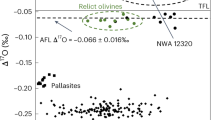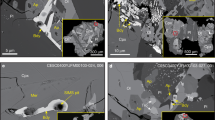Abstract
IN the Allende meteorite several elements are found to have an isotopic composition that cannot be due to radioactive or spallation or fractionation processes1. These isotope anomalies are mostly confined to white inclusions enriched in refractory elements2 (Ca–Al-rich inclusions) and are thought to be introduced into the Solar System by precondensed grains3. We have previously reported an anomalously high K–Ar age of a composite sample of five white inclusions from the Allende meteorite4; no direct verification of this lone-standing result of 4,800 Myr was possible because, with the exception of a small chip of one of the inclusions used for a thin section, the material was fused in the 40Ar–39Ar experiment. We therefore began a search for old material in other Ca–Al-rich inclusions. Three different samples from a new type of inclusion proved to be no older than most of Allende's constituents, 4,510 Myr (ref. 5). A small white inclusion gave a well developed 40Ar/39Ar plateau over almost the entire 39Ar release, with an age of 4,500±20 Myr (ref. 6). We report here on the 40Ar–39Ar analysis of two further coarsegrained Allende inclusions that showed ages in excess of 4,550 Myr.
This is a preview of subscription content, access via your institution
Access options
Subscribe to this journal
Receive 51 print issues and online access
$199.00 per year
only $3.90 per issue
Buy this article
- Purchase on Springer Link
- Instant access to full article PDF
Prices may be subject to local taxes which are calculated during checkout
Similar content being viewed by others
References
Schramm, D. N. & Clayton, R. N. Scient. Am. 98 (1978).
Grossman, L. Geochim. cosmochim. Acta 39, 433 (1975).
Lattimer, J. M., Schramm, D. N. & Grossman, L. Nature 269, 116 (1977).
Jessberger, E. K., Staudacher, Th., Dominik, B. & Herzog, G. F. Meteoritics 12, 266 (1977).
Dominik, B., Jessberger, E. K., Staudacher, Th., Nagel, K. & El Goresy, A. Proc. 9th Lunar Planet. Sci. Conf. (in the press).
Jessberger, E. K. Fortschr. Miner. 56, 53 (1978).
Cameron, A. G. W. & Truran, J. W. Icarus 30, 447 (1977).
Clayton, D. D. Nature 257, 36 (1975).
Clayton, D. D. Precondensed matter: Key to the early Solar System (preprint, 1978).
Clayton, D. D. Earth planet. Sci. Lett. 36, 381 (1977).
Jessberger, E. K., Kirsten, T. & Staudacher, Th. Proc. 7th Lunar Sci. Conf. 2201 (1976).
Wänke, H., Baddenhausen, H., Palme, H. & Spettel, B. Earth planet. Sci. Lett. 23, 1 (1974).
Bogard, D. D., Clark, R. S., Keith, J. E. & Reynolds, M. A. J. geophys. Res. 76, 4076 (1971).
Huneke, J. C. & Smith, S. P. Proc. 7th Lunar Sci. Conf. 1987 (1976).
Jessberger, E. K., Huneke, J. C. & Wasserburg, G. J. Proc. 5th Lunar Sci. Conf. 1419 (1974).
Huneke, J. C. & Wasserburg, G. J. Lunar planet. Sci. 9, 567 (1978).
Eichhorn, G., James, O. B., Schaeffer, O. A. & Müller, H. W. Lunar planet. Sci. 9, 279 (1978).
Schaeffer, O. A., Bence, A. E. & Eichhorn, G. Lunar planet. Sci. 9, 1004 (1978).
Jessberger, E. K., Kirsten, T. & Staudacher, Th. Proc. 8th Lunar Sci. Conf. 2567 (1977).
Dominik, B. & Jessberger, E. K. Earth planet. Sci. Lett. 38, 407 (1978).
James, O. B. & Blanchard, D. P. Proc. 7th Lunar Sci. Conf. 2131 (1976).
Black, D. C. & Pepin, R. O. Earth planet. Sci. Lett. 6, 345 (1969).
Clayton, R. N., Grossman, L. & Mayeda, T. K. Science 182, 485 (1973).
Wasson, J. T. : EOS 54, 1125 (1973).
Chou, Ch. L., Baedecker, P. A. & Wasson, J. Geochim. cosmochim. Acta 40, 85 (1976).
Mathis, J. S., Rumpl, W. & Nordsiek, K. H. Astrophys. J. 217, 425 (1977).
Lee, T., Papanastassiou, D. A. & Wasserburg, G. J. Astrophys. J. 220, 221 (1978).
Wasserburg, G. J., Lee, T. & Papanastassiou, D. A. Geophys. Res. Lett. 4, 299 (1977).
Lee, T., Schramm, D. N., Welfel, J. P. & Blake, J. B. Isotopic Anomalies from Neutron Reactions during Explosive Carbon Burning (Preprint, 1978).
Begemann, F. & Stegmann, W. Nature 259, 549 (1976).
Birck, J. L., Lorin, J. C. & Allegre, C. Meteoritics 12, 179 (1977).
Clayton, R. N. & Mayeda, T. K. Geophys. Res. Lett. 4, 295 (1977).
Author information
Authors and Affiliations
Rights and permissions
About this article
Cite this article
JESSBERGER, E., DOMINIK, B. Gerontology of the Allende meteorite. Nature 277, 554–556 (1979). https://doi.org/10.1038/277554a0
Received:
Accepted:
Published:
Issue Date:
DOI: https://doi.org/10.1038/277554a0
This article is cited by
-
The role of presolar dust in the formation of the solar system
Earth, Moon, and Planets (1988)
-
Meteoritics — more facts, more complexity
Nature (1981)
-
Allende meteorite—old age but normal isotopic composition of potassium
Nature (1979)
Comments
By submitting a comment you agree to abide by our Terms and Community Guidelines. If you find something abusive or that does not comply with our terms or guidelines please flag it as inappropriate.



